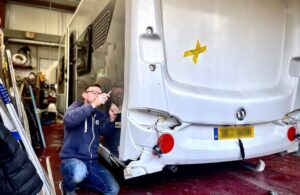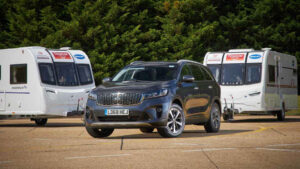Introduction to Carbon Monoxide
Explanation and Dangers
Carbon monoxide (CO) is often referred to as the “silent killer” because it is a colorless, odorless, and tasteless gas, making it virtually undetectable without the use of specialized equipment. It is produced when fuels such as gas, oil, coal, and wood do not burn fully. When inhaled, CO interferes with the blood’s ability to carry oxygen, leading to critical tissue damage and can be fatal in high concentrations or with prolonged exposure. In the confined space of a caravan, where ventilation may be limited, the risks associated with CO exposure can escalate rapidly, making understanding and mitigating these dangers paramount.
Real-life Incidents Related to CO Poisoning in Caravans
Real-life incidents of CO poisoning in caravans underscore the silent and insidious nature of this gas. There have been unfortunate instances where individuals, families, or pets have been adversely affected due to malfunctioning appliances, inadequate ventilation, or absence/lack of functioning CO detectors. These incidents serve as stark reminders of the importance of awareness, preparedness, and adherence to safety guidelines to prevent such tragedies from occurring in the future.
Understanding Carbon Monoxide Detectors
How They Work
Carbon monoxide detectors are designed to alert occupants to the presence of CO in the environment. They work by utilizing sensors that react to the gas and trigger an alarm when levels become hazardous. There are various types of CO detectors, such as biomimetic sensors, electrochemical sensors, and metal oxide semiconductors, each with their unique mechanisms for detecting the gas. Understanding how these devices work, their lifespan, and their operational requirements is crucial for ensuring they function effectively when needed.
Different Types and Brands
Different brands and models of CO detectors offer various features, such as digital displays, peak level indicators, and integration with smart home systems. Some detectors are battery-operated, while others can be plugged into wall outlets, and some models offer a combination of power sources. It’s essential to explore and understand the different types and brands available in the market, considering factors like reliability, ease of use, additional features, and customer reviews to make an informed decision that aligns with one’s needs and preferences.
Legal and Safety Guidelines
Laws Regarding CO Detectors in Caravans
Different regions may have specific laws and regulations regarding the use and placement of CO detectors in caravans. Some areas mandate the installation of CO detectors in rental caravans, while others may have guidelines for privately-owned ones. Understanding and adhering to these legal requirements is not only crucial for compliance but also for ensuring the safety of the caravan’s occupants. It’s advisable to consult local laws or caravan associations for accurate and up-to-date information.
Recommendations from Health and Safety Organizations
Various health and safety organizations, such as the Department of Health and Trade and Industry, provide recommendations and guidelines for CO safety in caravans. These may include optimal placement of detectors, maintenance guidelines, and safe usage of appliances that could emit CO. Adhering to these recommendations ensures that caravan users are aligning with expert advice, thereby maximizing their safety and minimizing the risk of CO exposure during their travels.
Detailed Guide on Positioning a CO Detector
Scientific Reasoning Behind Positioning
The positioning of a CO detector is pivotal in ensuring its effectiveness. Since CO is roughly the same density as air, it does not necessarily rise or sink, allowing it to spread evenly across a room. Therefore, detectors can be placed at any height, but it is crucial to position them where the alarm can be heard, and away from potential obstructions or areas of poor air circulation. The proximity to potential sources of CO, such as appliances, and sleeping areas should also be considered to provide timely alerts.
Diagrams and Illustrations for Clarity
Utilizing diagrams and illustrations in your guide can significantly enhance clarity and understanding regarding the optimal placement of CO detectors. Visual aids that depict the interior of a caravan, indicating potential CO sources, airflow, and recommended detector placements, can serve as a practical guide for readers. Additionally, providing visual examples of incorrect placements and explaining the reasons behind their inefficiency can further educate caravan users on avoiding common pitfalls.
Maintenance and Troubleshooting
Regular Checks, Battery Replacement, and Ensuring Functionality
Routine maintenance of CO detectors is vital to ensure they are operational when needed. Regular checks should include testing the alarm by pressing the “test” button, ensuring it is free from dust or debris, and replacing batteries as needed. Some detectors also feature end-of-life alerts, indicating when the unit needs to be replaced. Understanding and adhering to the manufacturer’s guidelines regarding maintenance and replacement ensures the detector’s reliability and functionality throughout its lifespan.
What to Do When the Alarm Sounds
Understanding the steps to take when a CO detector alarm sounds is crucial for safety. Immediate actions should include evacuating the caravan, ensuring all occupants are safe, and seeking fresh air. Once in a safe location, assess the health of all individuals and seek medical attention if any symptoms of CO poisoning (such as dizziness, headache, nausea, or confusion) are present. Only once it is safe to do so, and preferably by a professional, should the caravan be inspected to identify and rectify the source of the CO.
Case Studies
Instances of CO Poisoning in Caravans
Exploring real-world instances where individuals or groups experienced CO poisoning in caravans can provide tangible insights into the risks and consequences associated with CO exposure. These case studies often reveal common scenarios or oversights, such as malfunctioning appliances or inadequate ventilation, that led to the tragic events. By dissecting these instances, readers can gain a deeper understanding of the critical importance of CO awareness and safety practices, and how neglecting certain aspects can have dire consequences.
Lessons Learned and Precautions
Analyzing the lessons learned from each case study allows readers to understand what went wrong and how similar incidents can be prevented in the future. This could involve a deeper dive into the specific failures or oversights, such as neglected maintenance, improper appliance usage, or ignored CO detector alarms, that contributed to the incident. Outlining clear precautions, derived from these lessons, provides readers with actionable insights and strategies to safeguard against CO poisoning during their caravan adventures.
Additional Safety Measures
Ventilation Tips
Effective ventilation is paramount in preventing the buildup of CO within a caravan. Discussing tips such as ensuring adequate airflow when using fuel-burning appliances, being mindful of ventilation when parked, and understanding the importance of not obstructing vents or airways can be crucial. Highlighting the role of ventilation, not just in CO safety but also in maintaining a healthy and comfortable living environment within the caravan, can underscore its multifaceted importance.
Safe Usage of Appliances Within the Caravan
Educating readers on the safe usage of appliances, particularly those that burn fossil fuels, is pivotal in CO safety. This includes understanding the manufacturer’s guidelines, ensuring proper installation, and being mindful of operating these appliances in well-ventilated conditions. Additionally, discussing the risks associated with using certain appliances, such as gas stoves, as heating sources or operating them for prolonged periods can further enhance readers’ awareness and adherence to safe practices.
Traveling Safely with Children and Pets
Special Considerations for Their Safety
Children and pets may be particularly vulnerable to the effects of CO and may not be able to communicate or recognize symptoms of poisoning. Discussing the additional precautions and considerations, such as ensuring CO detectors are present and functional in areas they occupy and being mindful of their proximity to potential CO sources, can safeguard these vulnerable occupants. Additionally, providing tips on educating children about CO safety and ensuring pets have adequate ventilation and monitoring can enhance their safety during travels.
Emergency Preparedness
Outlining strategies and tips for emergency preparedness, particularly in scenarios involving children and pets, can be vital. This can include discussing how to safely evacuate a caravan with children and pets, ensuring they are familiar with CO alarm sounds, and having a well-thought-out plan that considers their unique needs and limitations. Additionally, providing insights into creating an emergency kit, including items specifically for children and pets, ensures that the family is well-prepared to handle any CO-related emergencies effectively.
Reviews and Recommendations
Reviewing Different Brands and Models of CO Detectors
Providing readers with reviews and insights into various brands and models of CO detectors can assist them in making informed purchasing decisions. Discussing aspects such as reliability, ease of use, additional features, and customer service can provide a comprehensive overview of what to expect from different detectors. Additionally, considering various use-case scenarios, such as long-term living versus occasional trips, can help tailor the reviews and recommendations to diverse reader needs.
Providing Purchase Links or Recommendations
Facilitating ease of purchase or further research for readers by providing purchase links, additional resources, or pointing them towards reputable retailers can add value and convenience. Ensuring that the recommendations and links provided are up-to-date and align with the discussed reviews enhances credibility and user experience. Additionally, providing options for various budgets and needs ensures that the recommendations are inclusive and considerate of the diverse reader demographic.
Conclusion
Summarizing Key Points
Concluding the article by succinctly summarizing the key points and takeaways provides readers with a quick recap and reinforces the crucial aspects of CO safety in caravans. Reiterating aspects such as the importance of CO detector placement, maintenance, and adherence to safety guidelines ensures that these pivotal points are emphasized and retained by the readers, enhancing the article’s impact and effectiveness.
Encouraging Safe Travel Practices
Ending the article on a note that encourages and advocates for safe travel practices can serve as a motivational and affirmational closing. Reminding readers of the joys and adventures that caravan travels can bring, and how adhering to CO safety practices ensures that these experiences remain positive and untainted by potential hazards, can leave them feeling informed and inspired. Additionally, encouraging them to share this vital information with fellow travelers can further amplify the impact and contribution towards collective safety and awareness.



